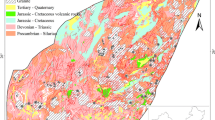Abstract
To quantify the spatial distribution of geochemical elements, the multifractality indices for Zn, Cu, Pt, Pd, Cr, Ni, Co, Pb, and As in lake-sediment samples in the Shining Tree area in the Abitibi area of Ontario are determined. The characterization of multifractal distribution patterns is based on the box-counting moment method and involves three functions: a mass exponent function τ(q); Coarse Hölder Exponent α (q); and fractal dimension spectrum f(α (q)). Properties of these functions at different values of q, characterize the spatial distribution of the variable under study. It is shown that the degree of multifractality defined by τ”(1) can be used as a measure of irregularity of geochemical spatial dispersion patterns. The variations of Zn and Cu in the study area are characterized by relatively low degree of multifractality, whereas those for Pt, Pd, Cr, Ni, and Co; and particularly for As and Pb are characterized by higher multifractality indices.In the case of Zn and Cu, singularity spectra are close to a monofractal compared to the ones for As an Pb. The determination of multifractality indices allows us, in a quantitative way, to study the pattern of metal dispersions and link them to different physical processes, such as metal adsorption by organic material or glaciogenic processes.
Similar content being viewed by others
REFERENCES
Ayer, J. A., Trowell, N. F., Madon, Z., Kamo, S., Kwok, Y. Y., and Amelin, Y., 1999, Compilation of the Abitibi greenstone belt, in the Timmins-Kirkland Lake areas: Revisions to stratigraphy and new geochronological results; in Summary of Field Work and Other Activities 1999: Ontario Geological Survey, Open File Report 6000, p. 4.1–4.14.
Carter, M. W., 1987, Geology of the Shining Tree area, Districts of Sudbury and Timiskaming: Ontario Geological Survey, Ontario, Canada, Report 240, 48 p.
Cheng, Q., 1994, Multifractal modeling and spatial analysis with GIS: gold potential estimation in the Mitchell-Sulphurets area, Northwestern British Columbia: Unpublished PhD Dissertation, University of Ottawa, 268 p.
Cheng, Q., and Agterberg, F. P., 1996, Multifractal modeling and spatial statistics: Math. Geol., v. 28, p. 1–16.
Cheng, Q., 1999, Multifractality and spatial analysis: Comput. Geosci., v. 25, no. 10, p. 1–13.
Cheng, Q., 2001, GeoDAS phase II. GeoData analysis system for mineral exploration and environmental assessment. User guide and exercise manual, York University, Canada, 298 p.
Colvine, A. C., Fyon, J. A., Heather, K. B., Marmont, S., Smith, P. M., and Troop, D. G., 1988, Archean lode gold deposits in Ontario; Ontario Geological Survey misc. paper 139, 136 p.
Fyon, J. A., Breaks, F. W., Heather, S. L., Jackson, T. L., Muir, T. L., Stott, G. M., and Thurston, P. C., 1992, Metallogeny of metallic mineral deposits in the Superior Province of Ontario, in Geology of Ontario, Ontario Geological Survey, Special Volume 4, part 2, p. 1091–1174.
Grassberger, P., and Procaccia, I., 1983, Measuring the strangeness of strange attractors: Physica D, v. 9, p. 189.
Halsey, T. C., Jensen, M. H., Kadanoff, L. P., Procaccia, I., and Shraiman, B. J., 1986, Fractal measures and their singularities: The characterization of strange sets: Phys. Rev. A, v. 33, n 2. p. 1141–1151.
Jackson, S. L., and Fyon, J. A., 1991, The Western Abitibi Subprovince of Ontario; in Geology of Ontario: Ontario Geological Survey, Special Volume 4, part 1, p. 1405–1482.
Johns, G. W., 1999, Precambrian geology, Shining Tree area (east half); Ontario Geological Survey, Preliminary Map P.3389, Scale 1 30000.
Johns, G. W., 2000, Precambrian geology, Shining Tree area (west half); Ontario Geological Survey, Preliminary Map P. 3420, Scale 1 30000.
Loehle, C., and Li, B., 1996, Statistical properties of ecological and geologic fractals: Ecol. Model., v. 85, p. 271–284.
Mandlebrot, B. B., 1983, The fractal geometry of Nature. W.H. Freeman, New York, 468 p.
Peitgen, H. O., Jürgen, H., and Saupe, D., 1992, Chaos and fractals: New frontiers of science; Springer-Verlag, New York, 971 p.
Panahi, A. Cheng, Q., and Bonham-Carter, G., 2003, Modeling lake sediment geochemical distribution using principal component, indicator kriging and multi-fractal power-spectrum analysis: A case study from Gowganda, Ontario: Geochemistry-Exploration, Environment, Analysis, v. 4, p. 59–70.
Rose, A. W., Hawkes, H. E., and Webb, J. S., 1979, Geochemistry in mineral exploration, 2nd ed.: Academic Press, London, 675 p.
Russell, D. F., and Hamilton, S. M., 2001, Shining Tree area high density regional lake sediment and water geochemical survey, northeastern Ontario: Ontario Geological Survey, Open File Report 6062, 79 p.
Sornette, D., 1998a, Multiplicative processes and power laws: Phys. Rev. E, v. 57, p. 4811–4813.
Sornette, D., 1998b, Linear stochastic dynamics with nonlinear fractal properties: Physica A v. 250, p. 295–314.
Author information
Authors and Affiliations
Rights and permissions
About this article
Cite this article
Panahi, A., Cheng, Q. Multifractality as a Measure of Spatial Distribution of Geochemical Patterns. Mathematical Geology 36, 827–846 (2004). https://doi.org/10.1023/B:MATG.0000041181.32596.5d
Issue Date:
DOI: https://doi.org/10.1023/B:MATG.0000041181.32596.5d




